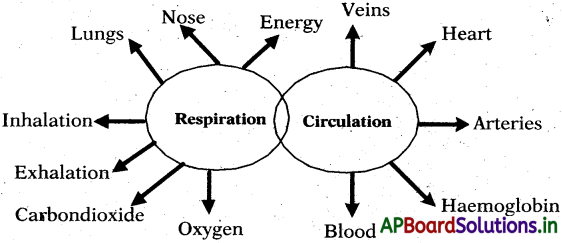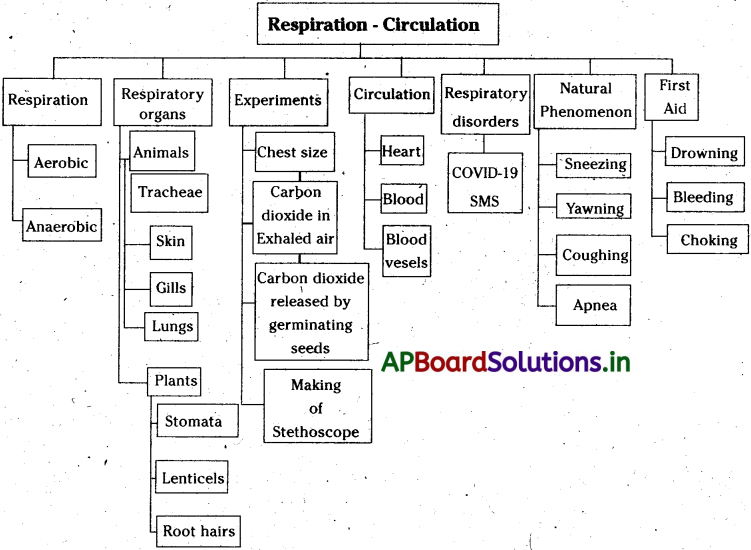Students can go through AP Board 7th Class Science Notes 4th Lesson Respiration and Circulation to understand and remember the concept easily.
AP Board 7th Class Science Notes 4th Lesson Respiration and Circulation
→ The process of inhaling and exhaling of air is called Breathing.
→ Respiration is essential for survival of living things.
→ The absorbed oxygen reaching every part of body and reacting with digested food to give energy is called respiration
→ Respiration is of two types:
a) Aerobic respiration (in presence of oxygen)
b) Anaerobic respiration (in absence of oxygen)
→ Breathing rate and heartbeat rate varies under different conditions.
→ The pathway of respiration is nostrils, nasal cavity, larynx, wind pipe, bronchi, and lungs.
![]()
→ The ribs and diaphragm play an important role in respiration.
→ Inhaled air has more oxygen and less carbon dioxide, where as exhaled air has lesser oxygen and more carbon dioxide.
→ Blood capillaries present in large numbers in the lungs absorb the inhaled oxygen and carry it to all parts of the body.
→ Hearts pumps the blood to all parts of the body through arteries and veins.
→ Plants respire through stomata of leaves and lenticels of stem. The roots also respire.
→ COVID – 19 is the latest universal respiratory disorder which can be prevented by sanitizing, using mask, and maintaining social distance.
→ There are a few natural involuntary phenomena related to the respiratory system like sneezing, yawning, coughing and apnea. These are not in our control.
→ Breathing : The process of inhalation and exhalation of air is called Breathing.
→ Inhalation : Intaking of air into the body is called inhalation. During the process of inhalation the air with more oxygen and less carbon dioxide enters the lungs through nostrils.
→ Exhalation : The process of breath out is called exhalation. During the process of exhalation the air with more carbon dioxide and less oxygen is sent out from the lungs.
![]()
→ Respiration : The absorbed oxygen reaching every part of body and reacting with digested food to give energy is called respiration.
→ Oxygen : It is the element that have a key role in respiration, it helps to burn the food material and release the energy
→ Carbon dioxide : It is the gas that released in respiration
→ Gills : These are the respiratory organs in aquatic animals like fishes.
→ Tracheae : Respiration that take place via trachea is called Tracheal respiration. This is present in all insects.
→ Bronchi : The branches of wind pipe extending into the lungs and further branching into bronchioles
→ Lungs : Lungs are pink in colour spongy, elastic and sac like structures with many tiny air sacs
→ Stomata : The process of breathing takes place with the help of small openings in the leaves called stomata.
→ Lenticels : These are small pore like structures on the stem involves in breathing.
→ Blood Capillaries : Blood capillaries which are very thin narrow blood vessels that connect the arteries with the veins and distribute the blood to the body parts.
→ Blood vessel : These are tube like structures through which the blood flows in the body. There are three types of blood vessels in the human body.
![]()
→ Tracheal system : Respiration that take place via trachea is called Tracheal respiration. This is present in all insects.
→ Haemoglobin : A red protein responsible for transporting oxygen in the blood of vertebrates
→ Arteries : They carry blood with more oxygen from heart to body parts.
→ Veins : They carry blood with more carbon dioxide from the body parts to the heart.

